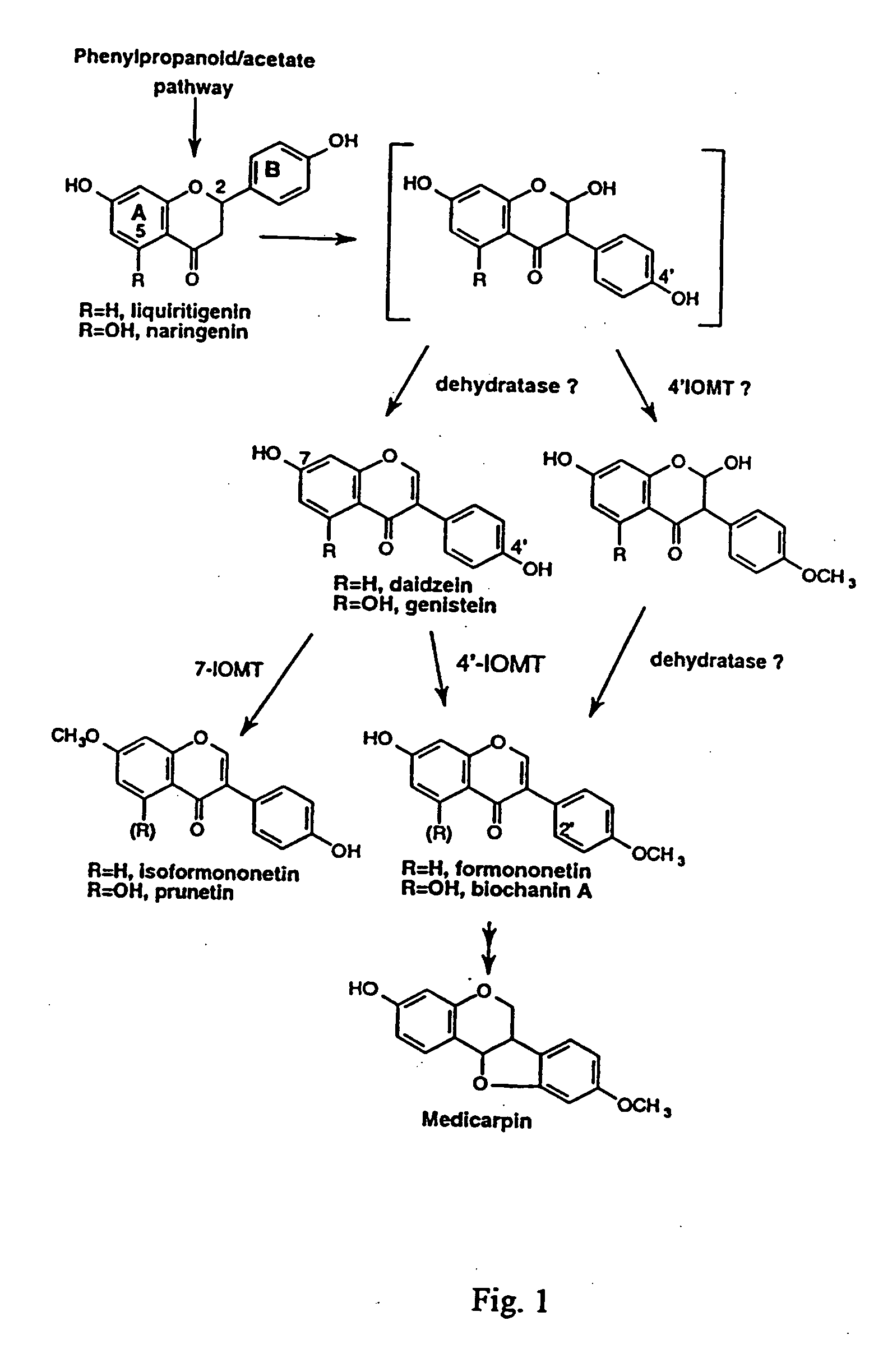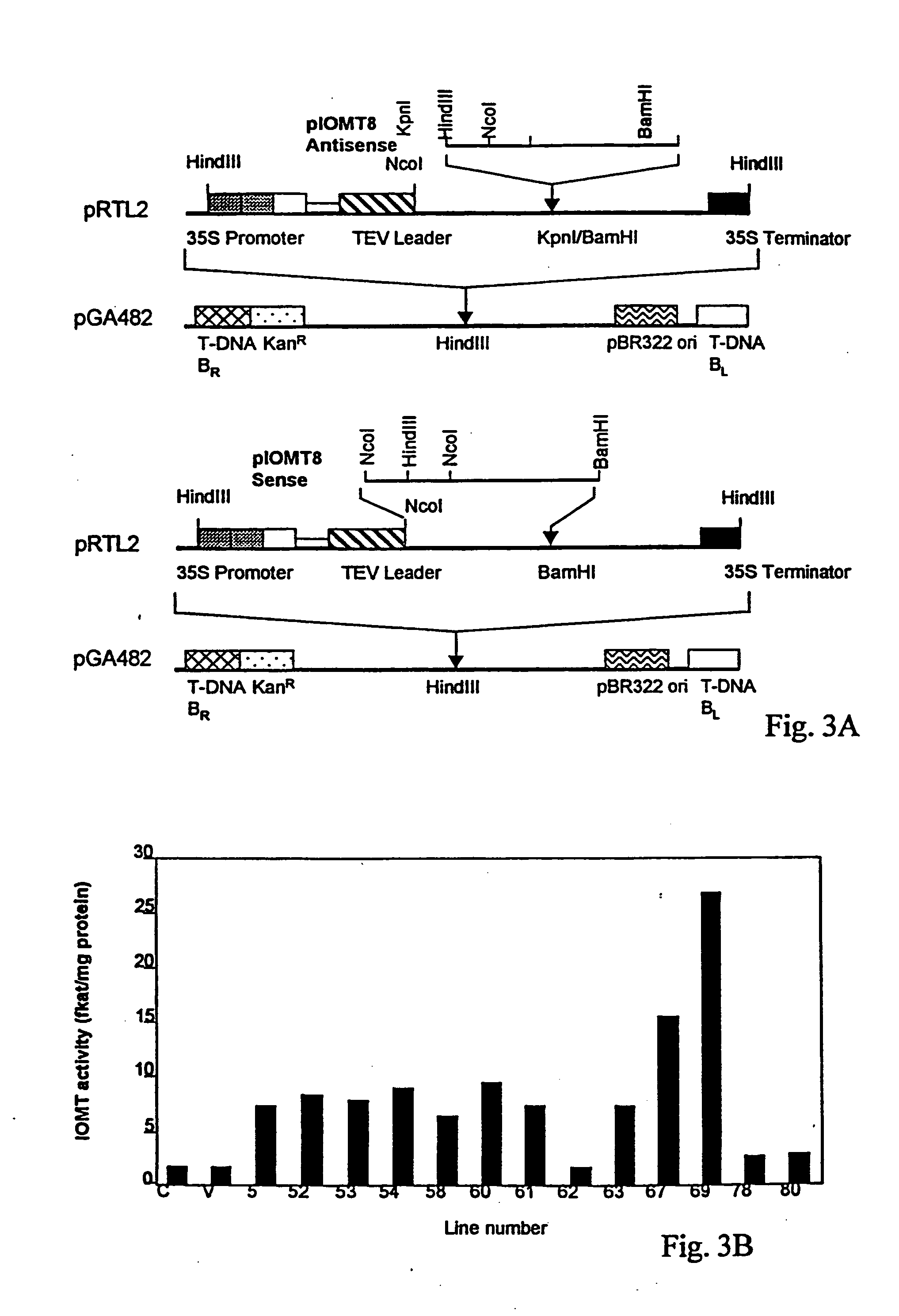Isoflavonoid methylation enzyme
a technology of isoflavonoid and methylation enzyme, which is applied in the field of plant gene manipulation, can solve the problems of not all the genes encoding the enzymes of isoflavonoid phytoalexin biosynthesis that have been cloned, and the exact mechanism of this o-methylation reaction remains unclear
- Summary
- Abstract
- Description
- Claims
- Application Information
AI Technical Summary
Benefits of technology
Problems solved by technology
Method used
Image
Examples
example 1
Construction and Characterization of Expression Plasmids Containing Exemplary IOMT cDNA
[0036] The full-length alfalfa IOMT8 cDNA (SEQ ID NO:1 and FIG. 2) was placed in the sense and antisense orientations under control of the cauliflower mosaic virus 35S promoter for constitutive expression in alfalfa. All recombinant DNA techniques were performed as described in Sambrook et al. (Sambrook, et al. 1989. Molecular Cloning. A Laboratory Manual (2nd Ed), Cold Spring Harbor Laboratory Press, New York). For sense vector construction, the expression plasmid pET15b / IOMT8, which contains the full-length IOMT8 cDNA (He, et al. 1998. Plant Mol Biol 36: 43-54), was digested with BamHI and NcoI. A 1.2 Kb fragment was isolated and subeloned into the NcoI and BamHI sites of plasmid pRTL2 (Restrepo, et al. 1990. “Nuclear trsport of plant polyviral proteins,”Plant Cell 2: 987-998): For antisense vector construction, the full length IOMT8 cDNA was amplified by polymerase chain reaction (PCR) using t...
example 2
Genomic Insertion of IOMT Transgene by Transformation of Alfalfa
[0037] Alfalfa (Medicago sativa L. cv. Regen S Y) was transformed and regenerated through somatic embryogenesis using kanamycin (25 mg / L) as selectable marker (Thomas, et al. 1990. “Selection of interspecific somatic hybrids of Medicago by using Agrobacterium-transformed tissue,”Plant Sci 69: 189-198). Trifoliate leaves were surface-sterilized for 10 sec in 70% ethanol and for 15 min in 1% (v / v) sodium hypochlorite solution containing 0.1% Tween 20 and then immersed for 10-15 min in a suspension of Agrobacterium LBA4404 harboring the IOMT constructs or empty vector (control). After rinsing with distilled water, tissues were blotted on a paper towel and plated on MS medium (Murashige, T. and Skoog, F. 1962. “A revised media for rapid growth and bioassay with tobacco tissue culture,”Physiol Plant 15: 473-497) containing B5 vitamins, 0.25 g / l casein hydrolysate, 10 μM 2,4-dichlorophenoxyacetic acid (2,4-D), 5 μM 6-benzyla...
example 3
Confirmation of IOMT Transgene by Use of Polyclonal Antiserum Against Alfalfa IOMT
[0039] IOMT transcripts are not expressed in healthy alfalfa leaves (He, et al. 1998. Plant Mol Biol 36: 43-54), and therefore, demonstration of the presence of IOMT activity in leaves confirms the expression of the IOMT transgene. Leaf tissue extracts from representative sense transformants and vector control transgenic alfalfa plants were, therefore, subjected to western blot analysis, using a polyclonal antiserum against alfalfa IOMT expressed in E. coli, to assess levels of ectopic expression of the enzyme in leaves. Polyclonal antiserum against IOMT was produced by immunizing rabbits (Covance Research Products Inc., Denver, Pa.) with the protein antigen expressed from E. coli (He, et al. 1998. Plant Mol Biol 36: 43-54). Protein extracts from leaf tissues were solubilized in sample buffer (25 mM Tris-HCl, pH 6.8, 1% SDS, 2.5% 2-mercaptoethanol, 5% glycerol). Proteins were separated by SDS-PAGE and...
PUM
| Property | Measurement | Unit |
|---|---|---|
| v/v | aaaaa | aaaaa |
| v/v | aaaaa | aaaaa |
| volumes | aaaaa | aaaaa |
Abstract
Description
Claims
Application Information
 Login to View More
Login to View More - R&D
- Intellectual Property
- Life Sciences
- Materials
- Tech Scout
- Unparalleled Data Quality
- Higher Quality Content
- 60% Fewer Hallucinations
Browse by: Latest US Patents, China's latest patents, Technical Efficacy Thesaurus, Application Domain, Technology Topic, Popular Technical Reports.
© 2025 PatSnap. All rights reserved.Legal|Privacy policy|Modern Slavery Act Transparency Statement|Sitemap|About US| Contact US: help@patsnap.com



